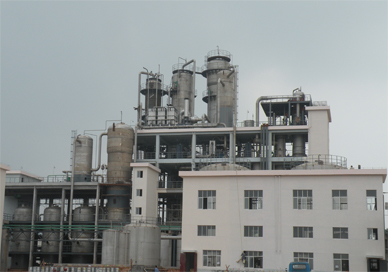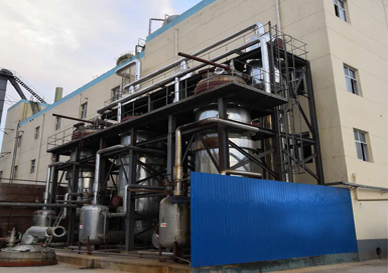Hot Selling for Forward Feed Triple Effect Evaporator - Hydrogen peroxide production process – Jinta
Hot Selling for Forward Feed Triple Effect Evaporator - Hydrogen peroxide production process – Jinta Detail:
Hydrogen peroxide production process
The chemical formula of hydrogen peroxide is H2O2, commonly known as hydrogen peroxide. Appearance is a colorless transparent liquid, it is a strong oxidant, its aqueous solution is suitable for medical wound disinfection and environmental disinfection and food disinfection. Under normal circumstances, it will decompose into water and oxygen, but the decomposition rate is extremely slow, and the speed of the reaction is accelerated by adding a catalyst – manganese dioxide or short-wave radiation.
Physical properties
The aqueous solution is a colorless transparent liquid, soluble in water, alcohol, ether, and insoluble in benzene and petroleum ether.
Pure hydrogen peroxide is a light blue viscous liquid with a melting point of -0.43 ° C and a boiling point of 150.2 ° C. The pure hydrogen peroxide will change its molecular configuration, so the melting point will also change. The solid density at the freezing point was 1.71 g/, and the density decreased as the temperature increased. It has a greater degree of association than H2O, so its dielectric constant and boiling point are higher than water. Pure hydrogen peroxide is relatively stable, and it is violently decomposed into water and oxygen when heated to 153 ° C. It is worth noting that there is no intermolecular hydrogen bond in hydrogen peroxide.
Hydrogen peroxide has a strong oxidation effect on organic substances and is generally used as an oxidizing agent.
Chemical properties
1. Oxidative
(Lead white in the oil painting [basic lead carbonate] will react with hydrogen sulfide in the air to form black lead sulfide, which can be washed with hydrogen peroxide)
(requires alkaline medium)
2. Reducing
3. In 10 ml of 10% sample solution, add 5 ml of dilute sulfuric acid test solution (TS-241) and 1 ml of potassium permanganate test solution (TS-193).
There should be bubbles and the coloration of potassium permanganate disappears. It is acidic to litmus. In case of organic matter, it is explosive.
4. Take 1 g of sample (accurate to 0.1 mg) and dilute to 250.0 ml with water. 25 ml of this solution was taken, and 10 ml of dilute sulfuric acid test solution (TS-241) was added, followed by titration with 0.1 mol/L potassium permanganate. 0.1 mol/L per ml. Potassium permanganate corresponds to 1.70 mg of hydrogen peroxide (H 2 O 2 ).
5. In the case of organic matter, heat, liberation of oxygen and water, in case of chromic acid, potassium permanganate, metal powder reacted violently. In order to prevent decomposition, a trace amount of a stabilizer such as sodium stannate, sodium pyrophosphate or the like may be added.
6. Hydrogen peroxide is a very weak acid: H2O2 = (reversible) = H++HO2-(Ka = 2.4 x 10-12). Therefore, the peroxide of the metal can be regarded as its salt.
The main purpose
The use of hydrogen peroxide is divided into medical, military and industrial uses. The daily disinfection is medical hydrogen peroxide. The medical hydrogen peroxide can kill intestinal pathogenic bacteria, pyogenic cocci, and pathogenic yeast, which are generally used for surface disinfection of objects. Hydrogen peroxide has an oxidation effect, but the concentration of medical hydrogen peroxide is equal to or lower than 3%. When it is wiped to the wound surface, it will burn, the surface will be oxidized into white and bubble, and it can be washed with water. After 3-5 minutes Restore the original skin tone.
The chemical industry is used as a raw material for producing sodium perborate, sodium percarbonate, peracetic acid, sodium chlorite, thiourea peroxide, etc., oxidizing agents such as tartaric acid and vitamins. The pharmaceutical industry is used as a bactericide, disinfectant, and oxidant for the production of thiram and 40 liters of antibacterial agents. The printing and dyeing industry is used as a bleaching agent for cotton fabrics and as a coloring agent for vat dyeing. Removal of iron and other heavy metals when used in the production of metal salts or other compounds. Also used in electroplating baths to remove inorganic impurities and improve the quality of the plated parts. Also used for bleaching wool, raw silk, ivory, pulp, fat, etc. High concentrations of hydrogen peroxide can be used as a rocket power fuel.
Civil use: to deal with the smell of the kitchen sewer, to the pharmacy to buy hydrogen peroxide plus water plus washing powder into the sewer can be decontaminated, disinfected, sterilized;
3% hydrogen peroxide (medical grade) for wound disinfection.
Industrial law
Alkaline hydrogen peroxide production method: a krypton-containing air electrode for producing alkaline hydrogen peroxide, characterized in that each pair of electrodes is composed of an anode plate, a plastic mesh, a cation membrane and a helium-containing air cathode, at the upper and lower ends of the electrode working area. There is a distribution chamber for entering the fluid and a collection chamber for discharging the fluid, and an orifice is arranged at the fluid inlet, and the multi-component electrode adopts a limited dipole series connection method to lengthen the plastic softness of the anode circulating alkali water inlet and outlet. After the tube is connected to the liquid collecting manifold, the multi-component electrode group is assembled by the unit plate.
Phosphoric acid neutralization method: it is characterized in that it is prepared from an aqueous sodium peroxide solution by the following steps:
(1) An aqueous solution of sodium peroxide is neutralized to a pH of 9.0 to 9.7 with phosphoric acid or sodium dihydrogen phosphate NaH2PO4 to form an aqueous solution of Na2HPO4 and H2O2.
(2) The aqueous solution of Na2HPO4 and H2O2 was cooled to +5 to -5 °C so that most of the Na2HPO4 was precipitated as Na2HPO4•10H2O hydrate.
(3) A mixture containing Na2HPO4 • 10H 2 O hydrate and an aqueous hydrogen peroxide solution was separated in a centrifugal separator to separate Na 2HPO 4 •10H 2 O crystals from a small amount of Na 2 HPO 4 and an aqueous hydrogen peroxide solution.
(4) The aqueous solution containing a small amount of Na2HPO4 and hydrogen peroxide was evaporated in an evaporator to obtain a vapor containing H2O2 and H2O, and a concentrated salt solution of Na2HPO4 containing hydrogen peroxide was discharged from the bottom and returned to the neutralization tank.
(5) The steam containing H2O2 and H2O is subjected to fractional distillation under reduced pressure to obtain about 30% H2O2 product.
Electrolytic sulfuric acid method: electrolyzed 60% sulfuric acid to obtain peroxodisulfuric acid, and then hydrolyzed to obtain a concentration of 95% hydrogen peroxide.
2-Ethyl oxime method: The main method of industrial scale production is the 2-ethyl oxime (EAQ) method. 2-ethyl hydrazine at a certain temperature.
The force reacts with hydrogen under the action of a catalyst to form 2-ethylhydroquinone, and 2-ethylhydroquinone generates oxygen with oxygen at a certain temperature and pressure.
Reduction reaction, 2-ethylhydroquinone is reduced to form 2-ethyl hydrazine and hydrogen peroxide is formed. After extraction, an aqueous hydrogen peroxide solution is obtained, and finally purified by heavy aromatic hydrocarbon to obtain a qualified aqueous hydrogen peroxide solution, commonly known as hydrogen peroxide. Most of this process is used to prepare 27.5% hydrogen peroxide, and a higher concentration aqueous hydrogen peroxide solution (such as 35%, 50% hydrogen peroxide) can be obtained by distillation.
Product detail pictures:

Related Product Guide:
We take "customer-friendly, quality-oriented, integrative, innovative" as objectives. "Truth and honesty" is our administration ideal for Hot Selling for Forward Feed Triple Effect Evaporator - Hydrogen peroxide production process – Jinta , The product will supply to all over the world, such as: Sri Lanka, Jordan, Grenada, Our products have enjoyed a great reputation for their good quality, competitive prices and prompt shipment in international market. Presently, we are sincerely looking forward to cooperating with more overseas customers based on mutual benefits.
This manufacturer can keep improving and perfecting products and service, it is in line with the rules of market competition, a competitive company.




